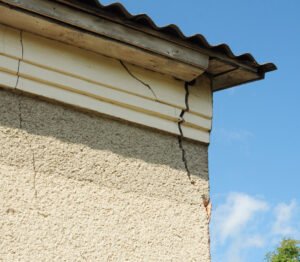Subsidence
Subsidence can be an expensive problem to solve; there are no quick fixes here. Every property owner needs to be aware of the telltale signs of subsidence and what measures to take if they encounter them. By following a tried and tested predetermined process, homeowners affected by subsidence can react promptly, get a confirmation of their diagnosis quickly, and repair the problem as fast and cost-effectively as possible.
What is subsidence?
 Subsidence is a serious issue that occurs when the ground beneath a property starts to sink. As the ground moves downwards, foundations can become misaligned, and numerous problems can arise as a result. Every homeowner should know the signs of subsidence and what to do if they suspect their property is beginning to subside. While new builds are expected to shift slightly on their foundations as they settle, this is very different from subsidence, which has the potential to threaten a home’s integrity.
Subsidence is a serious issue that occurs when the ground beneath a property starts to sink. As the ground moves downwards, foundations can become misaligned, and numerous problems can arise as a result. Every homeowner should know the signs of subsidence and what to do if they suspect their property is beginning to subside. While new builds are expected to shift slightly on their foundations as they settle, this is very different from subsidence, which has the potential to threaten a home’s integrity.
Below is a quick guide to the most common signs and causes of subsidence, and what you as a homeowner need to know about the phenomena. As long as you respond swiftly, it’s possible to limit the damage subsidence causes when it does occur.
How to check for subsidence
Subsidence is the kind of problem that will usually reveal itself to you without you having to go and look for it. In most cases, the first indication a homeowner will have that subsidence is on the cards will be one of the signs outlined below. Cracks in your property’s interior or exterior walls without an apparent cause are often due to subsidence. Similarly, if doors and windows are getting harder to open and developing a tendency to stick, subsidence is a likely culprit.
You should always be vigilant for the signs of subsidence we have outlined below. If you notice one of the common indications of subsidence on your property and you can’t find an alternative explanation, you should consult with a construction professional to assess precisely what the problem is and, if it is due to subsidence, how advanced it is.
Signs of subsidence
 Fortunately, subsidence tends to be a fairly obvious issue when it does occur. The three most prominent signs of subsidence in a house are as follows:
Fortunately, subsidence tends to be a fairly obvious issue when it does occur. The three most prominent signs of subsidence in a house are as follows:
- Cracks: The most notorious sign a home is subsiding are visible subsidence cracks inside the property. Needless to say, visible structural damage is never a good thing for any property. As soon as you notice cracks in your walls, you should consult with a professional building expert to assess the damage and ensure your home is still safe to live in.
- Sticking doors and windows: If your home’s features are beginning to stick or resist being opened and closed, you should consider subsidence as the cause. Whereas various issues can cause cracks in your walls, sudden sticking throughout your property is a more clear-cut indication that you have a subsidence problem.
- Rippling or peeling wallpaper: The structural problems caused by subsidence often reveal themselves as imperfections in your wallpaper. If subsidence is causing your walls to deform or crack, any wallpaper on top of them will similarly be affected.
How to spot subsidence cracks

You can differentiate between subsidence cracks and other forms of structural damage by how suddenly the cracks appear. Most cracks that arise from structural damage will start off small and gradually get worse over time. By contrast, subsidence cracks will appear suddenly. Subsidence cracks also follow a zig-zagging pattern because they follow the mortar lines of the property’s brickwork.
Cracks due to subsidence are relatively large. In most cases, you will be able to fit your little finger into the external and internal cracks.
Cracks that don’t fit this profile may well be caused by something other than subsidence. Any cracks in the walls, floors, or ceilings of your property need investigating promptly. It’s important to know what’s caused them and whether they indicate a more severe problem elsewhere.
How to rectify subsidence
 Unless you have considerable experience with construction, you shouldn’t try to rectify subsidence on your own. Subsidence that is left untreated will only get worse until it eventually threatens the integrity of your home. If you plan on shoring up your home on your own, you should do so under the supervision of a professional who can ensure you are taking all the appropriate measures.
Unless you have considerable experience with construction, you shouldn’t try to rectify subsidence on your own. Subsidence that is left untreated will only get worse until it eventually threatens the integrity of your home. If you plan on shoring up your home on your own, you should do so under the supervision of a professional who can ensure you are taking all the appropriate measures.
The faster you diagnose subsidence and begin treating it, the more likely you are to be successful. If you have home insurance, your insurance company can send a loss adjuster to investigate and recommend the best course of action. If you require specialist contractors’ assistance, your insurer can also connect you to the right people. How much of this you need to do yourself and how much it costs you will depend on your level of cover and how advanced the subsidence is.
One of the most common causes of subsidence, which could be responsible for as many as 70% of all cases, is tree root damage. Just because we can’t see tree roots from above ground, that doesn’t mean they can’t affect our properties. Tree roots draw moisture from the surrounding soil. Prolonged spells of dry weather will prevent the soil from replenishing any moisture lost to tree roots.
Removing trees can potentially provide a quick solution to subsidence problems. However, in some rare cases, removing trees causes its own set of problems; something known as ‘heave.’ Heave occurs when the ground beneath a property swells due to excess moisture. Without the tree roots there to draw moisture from the soil, it can rapidly become saturated as levels rise rapidly. Before removing trees from your property, you should consult with an arboriculturist; they are experts in tree and root control.
Another potential cause of subsidence is the pipework beneath your home and within your foundations. A leaking or burst pipe can release significant amounts of water and lead to the earth being washed away from the base of your property. The combination of excess water and a sudden lack of earth around your property’s foundations can cause structural issues, including subsidence. A CCTV drain survey will reveal any problems with your pipework, which a professional contractor can then rectify. These repairs are considerably cheaper than underpinning, so it is always worth checking the pipework before commissioning more expensive works.
Subsidence underpinning
In the most severe cases, underpinning is required to reinforce a property suffering from subsidence. Underpinning will prevent any further movement of the property’s foundations and should therefore put an end to the damage caused by subsidence. However, underpinning is an expensive and time-consuming process; it’s not the kind of thing most people can do on a whim. The precise cost of underpinning will depend on your property’s size and the extent of the damage so far.
The good news is that only around 10% of properties affected by subsidence will progress to the point where underpinning becomes necessary. In fact, the Institute of Structural Engineers advises property owners to try every other available solution before committing to underpinning. If you’re unsure about the extent of subsidence damage to your property and what the best solution is, consult with a professional construction business before pursuing underpinning.
Internal signs of subsidence
Subsidence cracks are often clearly visible on a property’s exterior, but there are a host of signs that will only become apparent when you’re inside the property. Checking the state of your home interior against pictures of subsidence inside a house can be very helpful when you’re trying to diagnose the issue.
For example, many subsiding properties will have sinking or sloping interior floors. These deformations occur because the ground beneath the property is no longer as sturdy as it once was and is starting to collapse. A spirit level will reveal whether your floors are still flat or not. Unless an architect has designed your home to have sloping floors, you should take any deviations seriously. Left untreated, an imperceptible amount of sloping or sinking could soon devolve into a serious issue.
Another sign of subsidence that you won’t notice unless you’re inside a property is skirting boards coming away from the walls. As your home sinks due to subsidence, visible gaps will develop between the skirting boards and your walls.
As always, with home maintenance, prevention is the best cure. Anything you can do to reduce the chances of subsidence occurring could end up saving you a lot of time and money down the line. One simple measure is to limit the number of trees and shrubs in your garden. Before planting any new specimens, it’s worth consulting with an arboriculturist to ensure you aren’t going to dry out your soil and compromise your property’s integrity. Ensuring that your drains are well-maintained and any blockages are removed swiftly will also reduce the chances of flooding and oversaturation.
If you suspect that your property is beginning to subside, contact a professional chartered surveyor immediately for a proper assessment. You don’t want to take any risks when it comes to the structural integrity of your home.
